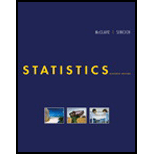Sorry! We don’t have solutions for this edition yet.
Solutions are available for other editions of this book
View 13th Edition solutionsarrow_forwardBook Details
1. Statistics, Data, and Statistical Thinking 1.1 The Science of Statistics 1.2 Types of Statistical Applications 1.3 Fundamental Elements of Statistics 1.4 Types of Data 1.5 Collecting Data 1.6 The Role of Statistics in Critical Thinking Statistics in Action:USA WeekendTeen Surveys - Are Boys Really from Mars and Girls from Venus? Using Technology: Creating and Listing Data in MINITAB
2. Methods for Describing Sets of Data 2.1 Describing Qualitative Data 2.2 Graphical Methods for Describing Quantitative Data 2.3 Summation Notation 2.4 Numerical Measures of Central Tendency 2.5 Numerical Measures of Variability 2.6 Interpreting the Standard Deviation 2.7 Numerical Measures of Relative Standing 2.8 Methods for Detecting Outliers (Optional) 2.9 Graphing Bivariate Relationships (Optional) 2.10 Distorting the Truth with Descriptive Techniques Statistics In Action: The "Eye Cue" Test: Does Experience Improve Performance? Using Technology: Describing Data in MINITAB
3. Probability 3.1 Events, Sample Spaces, and Probability 3.2 Unions and Intersections 3.3 Complementary Events 3.4 The Additive Rule and Mutually Exclusive Events 3.5 Conditional Probability 3.6 The Multiplicative Rule and Independent Events 3.7 Random Sampling 3.8 Some Counting Rules (Optional) 3.9 Bayesrsquo; Rule (Optional) Statistics In Action: Lotto Buster! - Can You Improve Your Chances of Winning the Lottery? Using Technology: Generating a Random Sample in MINITAB
4. Discrete Random Variables 4.1 Two Types of Random Variables 4.2 Probability Distributions for Discrete Random Variables 4.3 Expected Values of Discrete Random Variables 4.4 The Binomial Random Variable 4.5 The Poisson Random Variable (Optional) 4.6 The Hypergeometric Random Variable (Optional) Statistics in Action: Probability in a Reverse Cocaine Sting - Was Cocaine Really Sold? Using Technology: Binomial, Poisson, and Hypergeometric Probabilities in MINITAB
5. Continuous Random Variables 5.1 Continuous Probability Distributions 5.2 The Uniform Distribution 5.3 The Normal Distribution 5.4 Descriptive Methods for Assessing Normality 5.5 Approximating a Binomial Distribution with a Normal Distribution (Optional) 5.6 The Exponential Distribution (Optional) Statistics in Action: Super Weapons Development - Is the Hit Ratio Optimized? Using Technology: Normal Probability Plots in MINITAB
More Editions of This Book
Corresponding editions of this textbook are also available below:
